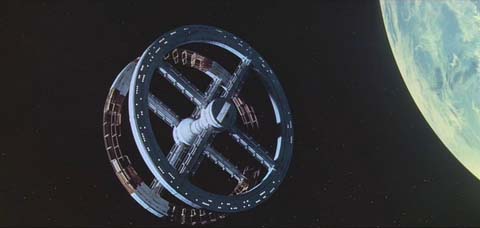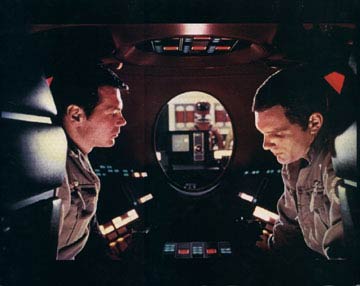
Plot info:
A tribe of prehistoric man-apes is struggling to survive in the dry desert. One morning, a mysterious black rectangular monolith appears near their habitation and is nervously examined by the apes. Following this encounter, a lone man-ape (Daniel Richter) invents the first tool while scavenging through a pile of bones. The man-ape picks up a bone and plays with it, finally crushing the other bones, as with a club. The man-ape who created the tool, now leading the tribe and standing partially upright, defends their waterhole from another tribe, clubbing an enemy ape to death with the new-found weapon — man has learned to kill using tools. The victorious man-ape throws his weapon into the air, at which point the film cuts forward to the future, matching the image of the tumbling bone to that of a man-made orbital satellite.

A Pan Am spaceplane, carrying only one passenger, Dr. Heywood R. Floyd (William Sylvester) docks to an Earth-orbital space station. While aboard, Floyd meets a group of Soviet scientists, including an old friend. Floyd reveals that he is traveling to the Moon base in the crater Clavius. Dr. Andrei Smyslov (Leonard Rossiter) inquires as to why nobody had been able to establish contact there and mentions that the base recently denied emergency landing to a Soviet shuttle (a direct violation of space travel rules). Floyd feigns naïve surprise, but when Smyslov alludes to intelligence reports that an unusual epidemic has broken out at the base, Floyd ominously refuses to comment, citing security restrictions.
On the Moon Base Clavius, Floyd meets the base's scientists and administrators and speaks on the importance of hiding the true reason for the base's suspicious quarantine. He states that the "cover story" of an epidemic and a base-wide communications black-out will remain in effect until decided otherwise by their superiors on Earth. He reminds them of "the potential for cultural shock and social disorientation" that their discovery presents. Though ostensibly there to assess the situation and make a report, Floyd informs those present that new "security oaths" are required from all personnel.
During a later moonbus ride to the excavation, a discussion between Floyd and a base administrator reveals they have discovered an alien object, "deliberately buried" on the Moon four million years earlier. At the dig site, the scientists approach an identical monolith to that found by the man-apes; like them, Floyd strokes the smooth surface of the object. The scientists gather around it for a group photo but are interrupted when an earsplitting, continuous high-pitched tone is picked up by their radio receivers.
Three of the Discovery One crew are in a state of hibernation, ostensibly to conserve resources for the voyage.Aboard the spaceship Discovery One, bound for Jupiter, are the mission pilots, astronauts Dave Bowman (Keir Dullea) and Frank Poole (Gary Lockwood), and three scientists "sleeping" in cryogenic hibernation. The two crewmen watch a BBC television program about themselves, in which the "sixth member" of the crew, the HAL 9000 supercomputer (Douglas Rain), is introduced and interviewed. The interview reveals that the supercomputer is the pinnacle in artificial machine intelligence, with a remarkable, error-free performance record. It is designed to communicate and interact like a human, and even mimics (or reproduces) human emotions; in fact the astronauts have learned to treat it like another crewman, addressing it as "Hal".
During an informal conversation with Bowman, HAL raises concerns about the unusual secrecy surrounding the mission, and repeats rumors about "something being dug up on the moon." When Bowman suggests that HAL's quizzical conversation is actually part of his "crew psychological profile," HAL feigns embarrassment, then abruptly reports an imminent equipment malfunction. HAL claims to have detected a defect in a component of the ship's communications system. Bowman exits the Discovery in an EVA pod to retrieve and replace the faulty AE-35 unit, but upon detailed examination no fault can be found. Mission controllers back on Earth assert that HAL is "in error in predicting the fault", something unheard of for the 9000 series. HAL suggests another EVA mission to restore the part and wait for it to fail, to determine the problem. Hiding their concern, Bowman and Poole retreat to an EVA pod to discuss HAL's questionable reliability in secret, finally agreeing to "disconnect" him should the AE-35 not fail, as HAL predicted. Unbeknownst to them, HAL is reading their lips.
Poole exits the Discovery in an EVA pod to put back the original component while Bowman watches from inside the ship. After Poole exits the pod, HAL takes control of the empty pod and accelerates it towards Poole, murdering him. Bowman hurriedly exits the ship in another pod to rescue Poole (forgetting to bring his space helmet). While Bowman is outside, HAL kills the three hibernating scientists by deactivating their life support systems.
Upon returning to the ship with Poole's lifeless body, Bowman is refused reentry into the ship by HAL. HAL reveals that he knows of Poole and Bowman's plan to disconnect him, and asserts that the mission is "too important" to allow Bowman to jeopardize it. HAL terminates the conversation. After jettisoning Poole, Bowman opens an air lock, and activates the pod's emergency hatch bolts. The explosive decompression propels him into the airlock, exposed to the vacuum of space without a helmet, but he manages to close and pressurize the airlock.
Bowman enters HAL 9000's Central Core in the Discovery to disconnect his "higher functions."Safely inside the ship, Bowman enters HAL's Logic Memory Center. As HAL futilely attempts to negotiate with him, Bowman proceeds to disconnect his higher brain functions. HAL pleads and protests his termination, slowly regresses to past memories, and finally falls silent. Suddenly, a pre-recorded video briefing by Dr. Floyd plays, explaining the true nature of the mission — to investigate the signal sent to Jupiter from the alien artifact on the Moon. Floyd discloses that the secret mission had been known only to HAL until the ship's arrival in Jupiter space.
A third monolith is seen in orbit around Jupiter. As the planet and its moons and the monolith appear to align, Bowman exits Discovery One in a pod to investigate. Bowman appears to travel across vast distances of space and time through a "Star Gate," a tunnel of colorful light and sound. After passing over the landscape of an alien world, Bowman arrives in a Louis XVI-style room. As he walks about the room, he suddenly ages, first in his spacesuit, then in an ornate dressing robe, sitting down to a well appointed meal. He accidentally knocks his glass on the floor, smashing it and breaking the silence. Looking up from the broken glass, he sees himself lying on what appears to be his deathbed, at the foot of which appears a monolith. Bowman slowly reaches out to it and is transformed into a fetus-like being enclosed in a transparent orb of light — a "Star Child". Floating in space, the child gazes at the Earth beneath it.

Predicting the future?
The film shows an imagined version of the year 2001. Some of what is seen in the film has come to pass:
Flat-screen computer monitors (simulated by rear projection in the film).
Small, portable, flat-screen television sets.
Television screens with a wide aspect ratio.
Glass cockpits in spacecraft.
Home and business videoconferencing is available.
The proliferation of TV stations (the BBC's channels numbering at least 12).
Telephone numbers with more digits than in the 1960s. This is a function of having access to much of the human race, rather than one city or country.
The endurance of corporations like IBM, Aeroflot, and Hilton Hotels to the year 2001.
The use of credit cards with data stripes. (The card Heywood Floyd inserts into the telephone is of American Express; a close-up photo of the prop reveals that it contained a barcode rather than a magnetic strip, but the principle is the same. Some official identification cards now use PDF417 barcodes instead of magnetic strips.)
Biometric identification. The film shows voice-print identification on arrival at the space station.
The shape of the Pan Am Orbital Clipper was echoed in the X-34, a prototype craft that underwent towed flight tests from 1999 to 2001.
Bowman adjusts a control on his helmet when he is outside during his EVA that darkens his visor. Today's LCD technology can facilitate the electronic darkening of a normally transparent surface.

Great Movies
Home




